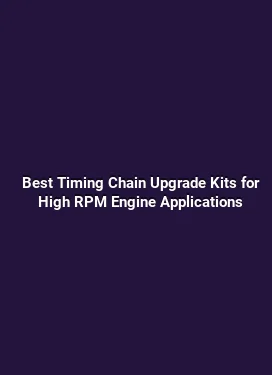Choosing Your Fuel: E85 Tuning and the Complete Guide to Flex-Fuel Conversions
Flex-fuel technology opens a broad spectrum of fueling options, allowing modern engines to run on gasoline, ethanol blends, or anything in between. Flex-fuel conversions and E85 tuning demand careful planning, precise calibration, and a deep understanding of how ethanol interacts with fuel delivery, ignition timing, and air-fuel management. This guide dives into the core concepts, practical steps, and actionable strategies that enthusiasts and professionals rely on when pursuing safe, reliable, and high-performance flex-fuel setups.
Understanding Ethanol-Based Fuel and Its Impact on Modern Engines

Ethanol blends, particularly E85 (85% ethanol, 15% gasoline), differ markedly from straight gasoline. Ethanol contains less energy per gallon, which can reduce peak power if the engine’s fuel and ignition maps are not adjusted accordingly. However, ethanol also carries advantages: higher octane, which supports more aggressive ignition timing, and a cooling effect during combustion, which can improve knock resistance when managed correctly. The key to unlocking these benefits lies in proper engine management, accurate fuel delivery, and sensor feedback that reflects real-time operating conditions.
Engine designers often implement flexible-fuel capabilities that rely on precise sensing of ethanol content. The vehicle’s fuel trims, oxygen sensor readings, and air metering data work together to ensure the engine maintains stoichiometry across a wide range of blends. When converting a vehicle to flex-fuel capability or tuning an existing flex-fuel system, the focus is on aligning fuel delivery with ethanol content, maintaining safe ignition timing, and preserving driveability across temperature and altitude variations.
Ethanol Content and Its Consequences for Calibration

Understanding ethanol content is foundational. Variations from 0% to 85% can shift optimal spark timing and fueling needs. Ethanol has a slower evaporative characteristic than gasoline, which means fuel atomization, spray patterns, and injector behavior must be accounted for during calibration. Higher ethanol content generally requires richer fueling and can tolerate more ignition advance, but only when the hardware and sensor feedback support stable operation. The calibration process involves iterative testing, data logging, and conservative safety margins to prevent lean hotspots or knock under load.
Another practical consideration is fuel system endurance. Ethanol is more corrosive to certain materials, and prolonged exposure can affect hoses, seals, and filters. When planning a flex-fuel conversion, selecting compatible components—ethanol-resistant injectors, lines, and seals—reduces long-term maintenance risk and helps preserve system integrity.
Fuel System Upgrades for Reliable E85 Tuning
Converting to E85 or optimizing a flex-fuel setup starts with the fuel delivery architecture.Stock injectors on many vehicles may handle E85 in light duty or partial blends, but higher ethanol content often demands larger injectors, improved fuel pressure regulation, and robust fuel pumps. A thoughtful upgrade strategy balances fuel capacity with the engine’s demand across rpm and load, ensuring that air-fuel ratios stay within safe and efficient ranges under all operating conditions.
Key components include high-flow fuel injectors designed for ethanol compatibility, a fuel pump capable of sustaining higher pressure and volume, and a regulator or returnless system that can maintain stable rail pressure during transitions. A reliable feed from the tank to the engine ensures consistent fueling, minimizes pressure drop under boost, and supports fast response to load changes during spirited driving or track use.
Injector Sizing and Fuel Rail Considerations
Injector sizing must match the engine’s maximum fuel demand at the chosen ethanol content and performance targets. Oversized injectors can impair idle quality and gasoline-like light-load fueling behavior, while undersized injectors risk rich conditions and missed targets under heavy load. When calculating needs, consider displacement, turbocharger or supercharger boost, intake airflow, and expected ethanol fraction. An adjustable or programmable fuel pressure regulator can help fine-tune rail pressure for optimal atomization and spray pattern at different operating points.
Fuel rails should provide clean, reliable routing for ethanol-rich fuels. If the vehicle uses a factory returnless system, confirm that the fuel pressure sensor, regulator, and pump can accommodate the more aggressive fueling profile required by E85. In turbocharged or supercharged builds, maintaining consistent rail pressure under boost is crucial for stable fueling and predictable power delivery.
Engine Management and Calibration for Flex-Fuel Systems
At the heart of any flex-fuel project lies the management system that interprets sensor data, adapts fueling, and controls ignition timing. Modern engine control units (ECUs) are capable of recognizing ethanol content through ethanol sensor input or programmed blend maps. The calibration process aligns fuel trims, injector duration, and ignition timing with real-time feedback from oxygen sensors, mass airflow, and manifold pressure readings to maintain optimal combustion across a wide range of conditions.
Successful tuning relies on a structured approach: baseline assessment, hardware verification, initial safe maps, and progressive refinement. Data logging is essential. A typical tuning session captures shaft horsepower, airflow metrics, engine knock margins, fuel trims, O2 sensor readings, and rail pressure. Interpreting this data helps identify lean or rich pockets, timing drift, or sensor misreadings that could compromise performance or reliability.
Ignition Timing, Knock Avoidance, and Octane Management
Ethyl-based fuels respond differently to timing than pure gasoline. The higher octane rating of ethanol blends allows for more aggressive ignition timing, which can yield improved power and throttle response. However, this potential is contingent on avoiding knock under load, especially at altitude, high ambient temperature, or when the engine approaches its redline. A precise knock detection strategy and a conservative timing map that adapts to ethanol content help preserve reliability while maximizing performance.
Octane demand is not solely a function of ethanol content. Boost pressure, compression ratio, cam timing, and cylinder pressure profiles play significant roles. A well-tuned system uses progressive timing advance with ethanol respect, ensuring safe margins during cold starts, high-load bursts, and heat soak scenarios. Calibrations often include dedicated warm-up routines and enrichment strategies to prevent misfires or detonation as the engine transitions through various operating states.
Sensor Strategy and Data Feedback for Flex-Fuel, Real-World Reliability
Accurate sensing is the backbone of a reliable flex-fuel platform. Big gains in performance come from sensors that deliver stable, repeatable data under dynamic conditions. The typical sensor suite includes wideband O2, MAP or MAF, throttle position, engine temperature, and, in some builds, a dedicated ethanol or ethanol-content sensor. The raw signals feed into the ECU, which translates them into precise fuel and timing commands across the engine’s operating envelope.
During tuning, sensor calibration cannot be overlooked. Oxygen sensor aging, sensor contamination, and wiring issues can skew feedback, leading to incorrect trims and degraded performance. Regular sensor health checks, correct grounding, shielded wiring for high-noise environments, and verified power supplies contribute to a predictable calibration process and consistent results across sessions.
Wideband Oxygen Sensors and Real-Time Feedback Loops
Wideband oxygen sensors provide a richer view of the air-fuel ratio than narrowband units. This capability is particularly valuable during transitions between gasoline and ethanol-rich blends. Real-time feedback allows the ECU to adjust injector pulse width and trim strategies with higher precision, ensuring the engine remains close to the target stoichiometry across a broad blend spectrum. A robust data logging setup captures both instantaneous readings and trend data, enabling the tuner to observe how quickly the system responds to changes and where lag might occur.
Additionally, monitoring manifold pressure and air intake temperatures helps quantify the cooling effect of ethanol and how it influences the timing map. When combined with a robust knock control strategy, this sensor suite supports aggressive yet safe calibration that unlocks the performance potential of flex-fuel configurations.
Practical Steps for a Safe and Effective Flex-Fuel Conversion
Converting or tuning for E85 involves a series of practical steps that blend hardware, software, and field testing. A structured workflow reduces the risk of unsatisfactory results and helps ensure reliability in everyday scenarios as well as track conditions.
First, establish your baseline. Document factory fuel system capabilities, current fuel trims, and stock ignition timing across a representative RPM/load matrix. This baseline serves as a reference point for the expected behavior after upgrades and tuning. Next, select hardware upgrades that align with your goals: ethanol-compatible injectors, a capable fuel pump, and, if needed, a flex-fuel sensor or calibrations that can interpret ethanol content. Resist the temptation to over-accelerate upgrades; architecture should reflect the engine’s actual demand and the intended application.
Calibration should proceed in phases. Start with a safe, conservative map that limits boost and ignition advance while ensuring stable idle and smooth transitions. Gradually push the blend ratio and operating load, logging data at each stage. Use wideband feedback to guide fuel trims, and verify corrections with physical checks such as spark plug color and cylinder pressure observations. This progressive approach helps reveal issues early, such as lean spikes under acceleration or inconsistent rail pressure under boost, allowing for targeted fixes before proceeding.
During long-term operation, maintenance becomes part of the tuning plan. Ethanol can affect fuel system components over time, so periodic inspections of seals, hoses, and pump performance are prudent. Temperature swings, humidity, and seasonal ethanol content variations should be anticipated in the calibration strategy, with maps reviewed and updated as necessary to preserve reliability and performance across the year.
Driving Experience, Safety Considerations, and Best Practices
The end goal of a well-executed flex-fuel project is not only peak horsepower but consistent, safe performance across daily driving, spirited sessions, and road trips. A core outcome is driveability: smooth idle, predictable throttle response, and reliable transitions between different ethanol contents as fuel quality changes. Practically, this means tuning for a broad operating envelope, validating with road tests, and maintaining a margin of safety for unexpected conditions such as hot weather or heavy traffic.
Safety is also about fail-safes and diagnostics. Implementing robust fault detection for fuel system anomalies, sensor disconnections, and abnormal trims helps prevent drivability issues or potential damage. Documentation of all changes, maps, and hardware configurations simplifies troubleshooting and future upgrades, ensuring that the flex-fuel system remains maintainable over time.
Track Preparation and Daily-Driven Reliability
For track-focused builds, the calibration mindset shifts toward repeatable performance and reliability under sustained high-load. This includes managing heat soak, ensuring sufficient fuel supply at high RPM, and validating that timing advances stay within safe limits even when ambient temperatures rise. For daily driving, the emphasis is on comfort and consistency: ensuring that the engine responds smoothly to a wide range of blends, with minimal surge or hesitation at cruise and low-speed throttle transitions.
In all cases, documenting your fuel strategy, sensor configuration, and tuning milestones creates a valuable roadmap for future work. A well-maintained log makes it easier to revert to a proven baseline if a problem occurs or if a new hardware upgrade is pursued.






